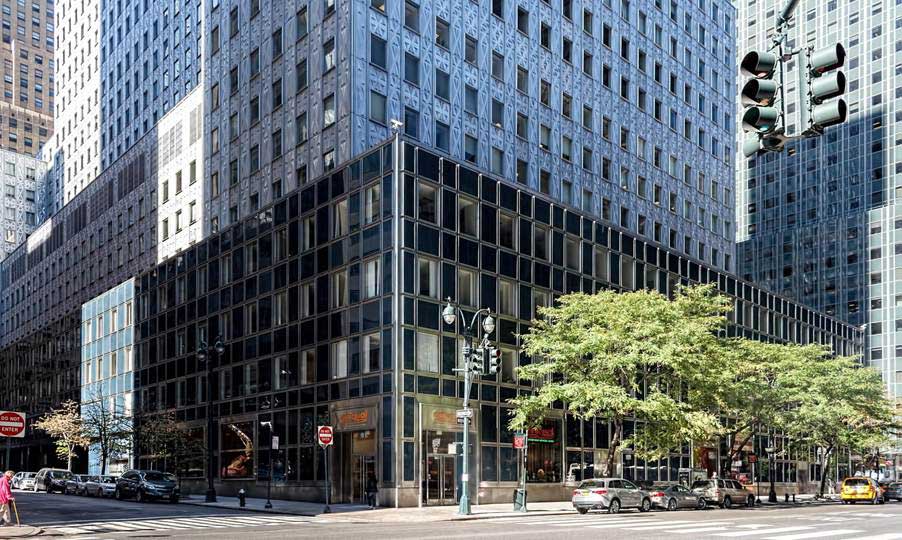Overview
Although the building industry had been thwarted by the Great Depression as previously introduced in the case of the Empire State Building, the application of stainless steel materials in construction proved its distinct advantages.
In 1948, stainless steel was firstly applied to the building curtain wall in the 4th-floor office at what was then called GE Schenectady Works, NY. Grade 302 stainless steel sheets of thickness 0.038"(0.97mm), wave shaped were assembled and fixed on the steel frames through spot welding. The thinness of the stainless steel panel undoubtedly increased the interior dimensions of the space.
However, have you ever given thought on when and where stainless steel is applied to the exterior wall of the building? In this article, we will explore stainless steel firstly applied to the exterior wall of building. It is Socony-Mobil Building built during 1954 and 1956.

Socony-Mobil Building
Socony-Mobil Building is a 1.61 million-square-foot, 42-level office tower situated in 50 East 42nd Street, New York City, USA. It was constructed in 1950s, initially serving as the headquarters of Socony Mobil Oil Company, now known as Exxon Mobil.
The building was constructed by Harrison & Abramowitz, which was then probably the city's best-known architectural firm, on land leased from the Goelet estate. It was a real estate investment made by Rockefeller Family but sold to a Japanese property firm Hiro Real Estate LLC for 240 million dollars in 1980s. Later on, several attempts to resell it, like to Tishman Speyer in 2008 and to the real estate investor David Werner in 2014, failed due to different reasons.
Socony-Mobil Building is close to the famous Chrysler Building, which was completed in 1930, when the use of stainless steel material was explored by its designer William Van Alen. The choice and final decision of using stainless steel in Socony-Mobil Building was not irrelevant with this precedent.
“Love-it or Hate-it” Critiques
Socony-Mobil Building remains one of these “love-it or hate-it” architectures in New York city. It appeared in several critics' "ugliest buildings" list, according to New York Architecture. Lewis Mumford, architecture critic for the New Yorker, viewed the design as a 'disaster' and said the elevations looked as if they were 'coming down with measles.' Elevators on the top few floors reportedly operate at 366 meters per minute.
However, in 2003 Socony-Mobil Building was landmarked "impressive skyscraper" with "dramatic stainless steel arches". Apart from modest alterations to the base and storefronts, Socony-Mobil Building stays as one of the postwar era’s and neighborhood’s most striking skyscrapers.

Stainless Steel As the Material
Socony-Mobil Building stands 174 meters tall, known for its exterior wall entirely clad with stainless steel. It was the largest metal clad building as well as the largest air-conditioned building all over the world by the time it was built in 1954. The use of dark blue opaque glass framed with smooth and embossed stainless steel panels enables Socony-Mobil Building to stand out amongst the competing masonry buildings and glass skyscrapers in the area.
Apart from the windows, the skyscraper is clad in over 7000 pieces of grade 302 embossed stainless steel panels. The thickness of these stainless steel sheets is only a bit over 1/32 inch, embossed to avoid bending, breaking and reflecting. The embossed patterns were 4 raised relief panels chosen from 100 different designs: a rosette-like motif for above and below the windows, a large and small rosette to flank the windows, and two variants displaying a design of interlocking pyramids.

Why Stainless Steel Material?
The architectural firm Harrison & Abramowitz were among the first to clad buildings entirely in metal, most notably, the Alcoa Building (1950-1953) in Pittsburgh. The metal materials dominated by bronze, aluminum, and stainless steel had obvious advantages such as ease of installation, the thinness advantages as mentioned above and low maintenance requirement. The first cleaning of Socony-Mobil Building occurred about 40 years later in 1995.
An interesting story of material choice has to be mentioned. Stainless steels were chosen among other metals for Socony-Mobil Building to a large degree because of Galbreath's ties to the steel industry. By that time aluminum were prevalent for the absolute price advantage. Stainless steels with larger density were considerably more expensive than other materials. To promote the application of stainless steel, the manufacturers agreed to match the price of aluminum and 'write off the cost of any price differential as the cost of promoting steel.'

Stainless Steel at CIVMATS
The earlier application of stainless steel sheets in architecture starts from grade 302, which is cheaper than the popular stainless steel 304. With the advanced technology, stainless steel costs have been considerably decreased. For many buildings constructed in recent decade, 316L stainless steel starts to get momentum.
At CIVMATS, we stock famous brands stainless steel flat products like stainless steel sheets plates coils that can be customized to your required dimensions. We also produce stainless steel long products with great quality. Welcome for your free consultation. Choose CIVMATS, choose reliability and safety.

